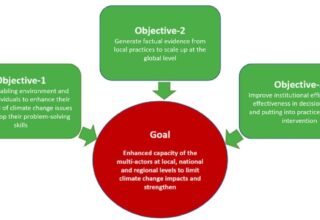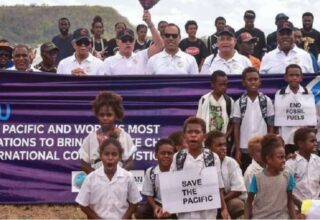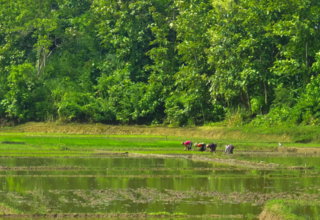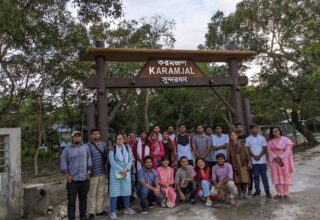If we are going to tackle climate change, the world will have to work together
As the COP22 winds down in Marrakesh, one of the low key but extremely important decisions made was setting up the Paris Committee on Capacity Building (PCCB). The committee will have the role of carrying out Article 11 of the Paris Agreement which is on the need to build long term capacity to tackle climate change in each and every country.
This is important because for countries to tackle climate change – whether by reducing greenhouse gas emissions or learning to adapt to new conditions – they will need to learn new skills and knowledge.
In many ways, creating this new committee challenges the old paradigm of capacity building, demanding a new way of doing things. I will explain the differences between the old and new paradigms of capacity building below:
Piece meal vs coordinated:
Currently, there is no UN oversight on how capacity building on climate change is conducted. Each developed country usually has its own capacity building programme and chooses which developing countries to support. The US may have a capacity building program in Ghana, the UK in Nepal, and Germany in Ethopia – but there is no coordination, making it difficult to determine who is doing what.
This has led to a fairly ineffective model for capacity building. Bilateral aid agencies such as DFID (UK), USAID (USA) and GIZ (Germany) usually just hire consultants from their own countries. These “experts” then fly into a developing country to carry out a workshop or two, fly back, write a report and capacity building has miraculously been done.
The problem is that this “fly in and fly-out” approach leaves little to no long term capacity in the targeted developing country. A few key people may be a more informed, but institutions themselves have not had their capacities built. Additionally, most of the budget is spent on developed countries’ own consulting companies, which is then often passed off as obligated Overseas Development Assistance or climate finance.
Under Article 11 of the Paris Agreement, the newly created PCCB will now have oversight of all these capacity building programmes and keep track of who is doing what and where. This will hopefully lead to more investment into long term capacity building.
Short term vs long term:
So far the focus of capacity building programmes described above has been on short term capacity building. Mostly this has been in terms of helping developing countries prepare reports and documents required by the UN climate process.
These documents include the NAPAs, the INDCs, the NAPs and more recently the NDCs. Even now there is a proliferation of capacity building programmes to prepare projects to submit to the Green Climate Fund for funding.
Unfortunately, simply preparing documents to submit to the UN climate body does not count as long term capacity building. These documents often do not have resonance in national planning, and through hiring a consultant, these programs do not create any sense of national ownership either.
The main paradigm shift between short term (as we have now) and long term capacity building is to “invest” in national capacity-building-systems in the developing country itself. The new way of doing things will involve in investing in institutions within the countries themselves that can do the capacity building.
While developed countries have spent several hundred million USD over the last few years on climate capacity building for climate change, very little has been invested in in-country capacity-building-systems such as universities.
Consultants vs Universities:
Every developing country, even the poorest, has at least one university whose role is to provide capacity building for the country’s future leaders on an ongoing basis.
Yet very few include the climate change in their teaching, training or research. This is partly because very little of the funding available for climate change capacity building has gone to universities (most goes to consulting companies or individual consultants, as I just wrote).
In the new paradigm of capacity building, we need to invest in long term in-country capacity-building-systems to carry on capacity building into the future.
Universities are a good option because around there world, there are schools that are over a thousand years old. As empires have come and gone, universities have persisted, and you cannot find a more sustainable institution than that.
Preparing documents vs taking actions:
The prevailing use of climate change capacity building programmes delivered through international consultants have been to prepare documents such as NAPs, NDCs, etc as mentioned above.
However, the greater need for capacity building is to take actions to tackle climate change in reality. This is better done through country to country knowledge exchange programmes where each country can share their own experiences with others and in turn learn from others.
This type of knowledge exchange programmes do not need to produce a new document although documentation of the process is important.
North-to-South vs South-to-South:
This type of knowledge exchange between countries is actually more useful and relevant when a developing country can learn from the experience of another developing country with similar problems which it has been successful in dealing with. For instance, when it comes to adaptation, developing countries have a lot more to learn from Bangladesh than the United Kingdom.
While lessons from developed countries are still useful, they tend to be less applicable in developing country contents.
More South-to-South, rather than just North-to-South, knowledge exchange programmes are now necessary.
One way vs two way
Another aspect of the current short term capacity building paradigm is the presumption that the international consultant flying into the developing country is there to teach the people of the developing country, and has nothing to learn from them as he or she is already an “expert”. Here the learning process is one way.
Under the new long term capacity building paradigm, the learning and teaching is a two way street where each individual is simultaneously both a teacher as well as a student. Thus, the relationships developed over time are those of mutual learning and knowledge exchange between equals rather than the “expert teaching the student”.
Mitigation vs adaptation:
The final point about the shift in paradigm is not so much about short term vs long term. but rather on which aspect of tackling climate change is focused on.
Most capacity building programmes funded by developed countries focus on how to reduce greenhouse gases emissions through mitigation. But most of the demand from developing countries, and especially from the poorest developing countries, is capacity building on adapting to climate change. Yet less money is going towards capacity building for adaptation.
If we are going to tackle climate change, the world will have to work together. Knowledge is no longer a gift from the Global North to the Global South, but a shared exchange. It is only by creating these sustainable, long term systems can we hope to take concrete climate action.
Originally this article was published on Saturday November 19, 2016 at Dhaka Tribune. The author Dr. Saleemul Huq is the director of the International Centre for Climate Change and Development (ICCCAD) at the Independent University, Bangladesh (IUB).
Email:
saleemul.huq@iied.org








